

Monday, December 19th, 2022
8am PDT
Room 2003, Elings Hall and via Zoom
Abstract
Immersive technologies are widely used in interactive media art and storytelling today. A high quality virtual environment and avatar can provide the audience a strong sense of presence and ownership of the virtual body, evoking empathetic outcomes from the experience. However, the majority of immersive art we encounter today shows a strong favoring of visual and auditory sensation over interactions. They provide the audience a limited number of ways to participate in an immersive narrative, leaving them a sense of being an “outsider” that breaks the connection between the audience’s virtual avatar and the virtual environment. Starting with Nicolas Bourriaud’s relational aesthetics for art creation and taking human relations and their social context as the main conceptual and practical point of departure for experience design, I develop artistic and technical strategies for creating immersive experiences that place the audience at the center to let them activate the narrative content and cultural meanings. My approach is to provide the user novel ways to relate themselves to what they see on a screen, and to allow for direct participation and engagement. Through an increased level of interactivity, co-presence and plausibility in immersive environments, my work aims to help the audience develop new relationships with other people, with virtual entities, and with AI agents. The hybrid systems introduced in this thesis describe novel ways for creating relational experiences by techniques learned from different domains such as soft robotics, quantum computing and social science. I also demonstrate authoring interface design that can be more widely adopted by the creative community to overcome the challenges often faced in immersive and interactive narrative compositions.
Saturday, December 3rd and Saturday, December 10th from 1-4pm
Elings Hall, room 2024
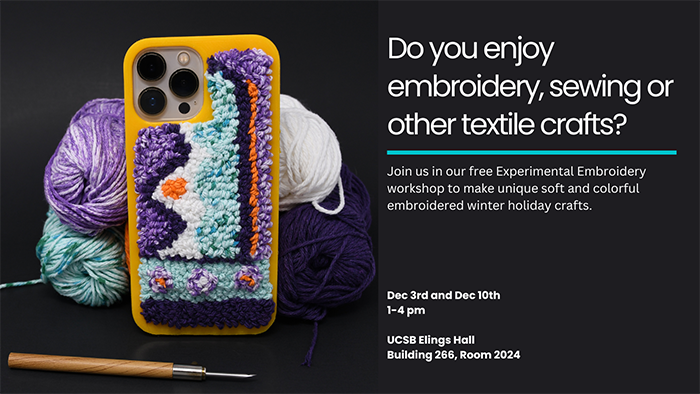
We’ll show you how to design and make 3D printed patterns to create soft 3D crafts like ornaments, decorations, and jewelry.
The workshop is free of charge and all materials will be provided. You must be 18 years or older, and available for both days of the workshop to participate.
Space is limited. To enroll complete and submit this form via the web: https://bit.ly/experimental-embroidery
For more information, please visit: https://ecl.mat.ucsb.edu/embroidery.

Speaker: Graham Wakefield
Monday, December 5th, 2022 at 1pm PST, Elings Hall room 2611 and via Zoom.

Abstract
The gen~ environment for Max/MSP lets us work on sonic algorithms down to sample and subsample levels. Written a decade ago during my doctoral research at MAT, UCSB, it has become a widely used platform for sonic experimentation, interactive arts, product design, and music making by artists such as Autechre, Robert Henke, and Jim O’Rourke. At its heart is the capacity to write whole algorithms that are processed one sample at a time, allowing unique access to filter, oscillator and other micro-level synthesis designs, and where each edit made while patching seamlessly regenerates optimized machine code under the hood (and which can be exported for use elsewhere). In this talk I will introduce the gen~ environment, including how and why it was developed, but also where and how it can be applied and what it has inspired. This will draw material from a new book about sonic thinking with signals and algorithmic patterns, with a gamut of synthesis and audio processing examples demystified through patching with gen~.
Bio
Graham Wakefield is an Associate Professor and Canada Research Chair in the department of Computational Arts at York University, where he leads the Alice Lab, dedicated to computational art practice and software development in mixed/hybrid reality. His ongoing research practice applies a deep commitment to the open-endedness of computation—as an art material—as expressed both in new software for artists and musicians (such as the gen~ environment for Max/MSP), as well as immersive artworks of biologically-inspired systems (working with Haru Ji as Artificial Nature). These installations have been exhibited in many international venues and events, including La Gaîté Lyrique/Paris and ZKM/Germany, and his research has been published in the Computer Music Journal, IEEE Computer Graphics & Applications, the International Journal of Human-Computer Studies, Leonardo, ICMC, NIME, SIGGRRAPH, ISEA, EvoWorkshops, and many more.
Graham Wakefield's new book (October 2022):
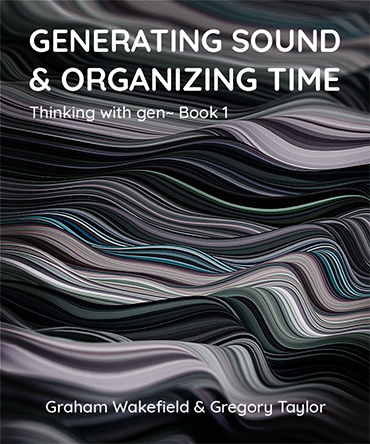
https://cycling74.com/books/go
For more information about the MAT Seminar Series, go to: seminar.mat.ucsb.edu.
For previous seminars, please visit our MAT Seminars Video Archive.
Friday, December 2nd, 2022 at 4pm PST
Music Building, Studio Xenakis, room 2215
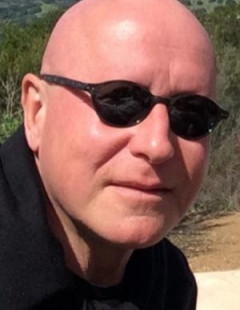
Abstract
In this talk, profesosor Roads will discuss past projects as well as current and planned projects in software development, music composition, and publishing.
Curtis Roads is professor and chair of Media Arts and Technology and affiliate faculty in Music at UCSB.
Friday, December 2nd, 2022 at 2pm PST
Music Building, Studio Xenakis, room 2215
Abstract
Dynamic Stochastic Synthesis (DSS) is a direct digital synthesis method invented by Iannis Xenakis that produces a wave of variable periodicity through regular stochastic variation of its wave cycle, resulting in emergent pitch and timbral features. While high-level parametric control of the algorithm enables a variety of musical behaviors, composing with DSS is difficult because its parameters lack basis in perceptual qualities. The Xenos virtual instrument plug-in implements DSS with modifications and extensions that enhance its suitability for general composition. Written in C++ using the JUCE framework, Xenos offers DSS in a convenient, efficient, and widely compatible polyphonic synthesizer that facilitates composition and performance through host-software features, including MIDI input and parameter automation. Xenos also introduces a pitch-quantization feature that tunes each period of the wave to the nearest frequency in an arbitrary scale. Custom scales can be loaded via the Scala tuning standard, enabling both xenharmonic composition at the mesostructural level and investigation of the timbral effects of microtonal pitch sets on the microsound timescale.
Speaker: Carmine Emanuele Cella
Monday, November 21, 2022 at 12pm PDT via Zoom.
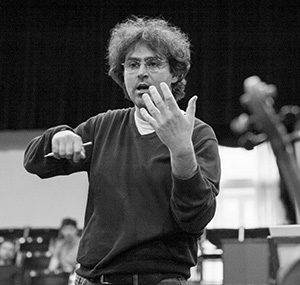
Abstract
The advancements in machine learning and, in particular, the recent breakthrough of artificial neural networks, has promoted novel art practices in which computers play a fundamental role to support & enhance human creativity. Alongside other arts, music and dance have also benefited from the development of machine learning and artificial intelligence to support creativity, for tasks ranging from music generation to augmented dance. This talk will present an overview of my research, focused on the intersection of artistic creation and performance, mathematical modelling, machine learning and human-computer interaction – and on their entwined co-evolution.
Bio
Carmine Emanuele Cella, is an internationally renown composer with advanced studies in applied mathematics. He is assistant professor in music and technology at CNMAT, University of California, Berkeley. He studied at Conservatory of Music G. Rossini in Italy getting diplomas in piano, computer music and composition and then studied composition with Azio Corghi at Accademia S. Cecilia in Rome; he also studied philosophy and mathematics and got a PhD in applied mathematics at the University of Bologna working on symbolic representations of music.
For more information about the MAT Seminar Series, go to: seminar.mat.ucsb.edu.
For previous seminars, please visit our MAT Seminars Video Archive.
Thursday, November 17th, 2022 at 11am PST.
Studio Xenakis, Music Building room 2215 and via Zoom.
Abstract
The use of space in music is a complex issue which involves several different, yet interrelated factors. The technical means of performance, the sonic material, and the overall musical aesthetic should all work together to produce a truly immersive experience and one which the listener can comprehend the spatial impression as independent and yet musically significant. Performances of spatial music typically involve a distributed audience and often take place in an acoustically reverberant space. This situation is quite different from the case of a single listener at home, or the composer in the studio or in a virtual reality setting with head mounted displays. As a result, spatial strategies which are effective in one context may not be transferable to another context. This thesis attempts to study the psychoacoustic factors or various music spatialization strategies in different contexts and in that process attempts to answer the question, What and how do psychoacoustic factors affect listening to music in non-virtual listening contexts and how could they transform when listening in a virtual listening context?
This question is answered through three psychoacoustic studies. The first one on Sound Source Distance, the second and third are comparative studies of music spatialization algorithms with different music genres – a loudspeaker study and a binaural analysis study. The last part of the thesis is to build a prototype of a virtual concert hall that uses some of the learnings of the aforementioned studies.
Monday, November 14th, 2022 at 2pm PDT
Elings Hall room 2003
Abstract
Live coding---the real-time procedural creation of audiovisual works---suggests opportunities to extend hand-drawn animation; however, existing live coding systems are incompatible with manual animation workflows. Manual input is not a primary datatype in existing live coding languages and live coding tools require using symbolic programming environments. I theorize that by applying direct manipulation to the domain of live coding, we can enable animators to create expressive mappings between hand-drawn animations and audio effects in real-time. I present Megafauna, a sketch-based system for audiovisual performance, informed by interviews with professional animators. Megafauna supports the integrated generation and control of hand-drawn animation and audio sequences by enabling animators to directly sketch mapping functions between animation frames and sound generators. I demonstrate the expressive potential of Megafauna by reproducing animated compositions from procedural and manual domains. I evaluate the opportunities of our approach for live production through an expert review of a performance piece created with Megafauna.
Speaker: Kurt Werner
Monday, November 14, 2022 at 1pm PDT via Zoom.

Abstract
In this talk, I present new designs for 1-bit synthesizers, audio effects, and signal mixers which transcend classical limitations of the (historically, very limited) format, creating new possibilities for musical expression. After reviewing some of the classical examples of 1-bit music, I will describe my novel approach to designing novel 1-bit musical tools. These include, e.g., 1-bit stochastic wavetables, resonant and comb "filters," artificial reverberation, advanced multiplexor- and digital-logic-based signal mixers, and advanced binary bitcrushers. Special emphasis will be placed on a new variant of sparse noise I developed called “Crushed Velvet Noise,” which is especially useful for 1-bit music.
Bio
Dr. Kurt James Werner conducts research related to virtual analog and circuit modeling, the history of music technology (especially drum machine voice circuits), 1-bit music, circuit bending, & sound synthesis more broadly, and sometimes composes too. As part of his Ph.D. in Computer-Based Music Theory and Acoustics from Stanford University's Center for Computer Research in Music and Acoustics (CCRMA), he wrote a doctoral dissertation “Virtual Analog Modeling of Audio Circuitry Using Wave Digital Filters.” This greatly expanded the class of circuits that can be modeled using the Wave Digital Filter approach, using the classic Roland TR-808 bass drum circuit as a case study. Currently based out of Somerville, MA, he was formerly an Assistant Professor of Audio at the Sonic Arts Research Centre (SARC) of Queen's University Belfast and a Research Engineer at iZotope, Inc.
For more information about the MAT Seminar Series, go to: seminar.mat.ucsb.edu.
For previous seminars, please visit our MAT Seminars Video Archive.
Friday, November 4th 2022 at 7:30pm at the Lotte Lehmann Concert Hall in the Music Building.
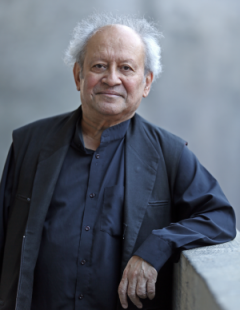
The CREATE concert Permutations and Combinations features the return from Barcelona of the UCSB Corwin Chair of Composition Emeritus Clarence Barlow. His algorithmically-composed music is both audiovisual and multichannel spatial.
Also featured is Dr. Rodney Duplessis, a recent UCSB graduate in music composition, and Drew Flieder, a current PhD student at UCSB. Professor Curtis Roads will also play a piece. The concert will conclude with a new ambisonic spatial work by the Paris-based composer Anne Sèdes. The duration of the concert is one hour.
Professor Barlow will also give a talk about the compositions he has worked on since 2019. Tuesday, November 8 2022 at 5pm, Studio Xenakis, Music Building room 2215.
The composition are:
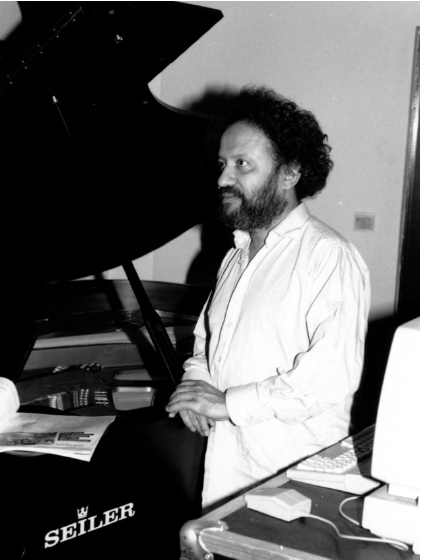
Clarence Barlow 1989
Friday, November 4th, 2022 at 3:30pm PDT.
Room 2003 Elings Hall and via Zoom.
Abstract
Before handheld cameras, most pictures and videos were taken in a carefully controlled professional setting and mainly produced for consumption beyond the individual. However, nowadays, the most significant portion of the world’s captured visual data are personal photos and videos taken by individual users. 3D content as a medium will go through this same recognizable phase. Most 3D experiences, video games, and movies are created by advanced users in professional settings. With the seemingly inevitable rise of Virtual and Augmented Reality, experiencing 3D content will no longer be limited to entertainment. We will be (and are beginning to be) able to see and share personal 3D content in everyday life.
In this dissertation, we address some of the open questions in the area of 3D content by studying user experiences in immersive environments and providing tools to create these environments from sparsely available building blocks more quickly using approachable user interfaces.
In our work PanoTrace, we introduce a 3D modeling platform for creating 3D scenes from 2D panoramas, and we measure the effects of added depth and degrees of freedom on various independent variables. Our results show higher immersion for 3D PanoTrace scenes when viewing in 6DOF. We also show that 6DOF tracked 3D panoramas lead to significantly better immersion, realism, and user comfort when compared to the original 3DOF panoramas.
In our second work, “Walking and Teleportation in Wide-area Virtual Reality Experiences,” we present the first VR study to understand the impact of natural walking versus teleportation in a large physical space on presence and user preference. Our results show that the participants overwhelmingly preferred walking, which tended to higher self-reported immersion, and that teleportation resulted in significantly higher self-reported simulator sickness.
We later discuss the application of intelligent systems in content creation and introduce DeepDive, a VR-ML installation that lets users infinitely dive into satellite images by incrementally increasing the resolution. As our next machine learning contribution, we present CASEIn, a Content-Aware Semantic Editing, and Inpainting system that generates state-of-the-art quality for image inpainting and image-to-image translation.
In the final chapter, we introduce Faded, a memory reconstruction system that extrapolates sparse information, like a handful of photos, into a cohesive 3D experience. Faded is a multi-component system that lets users create a layout of a 3D space from memory and place projected 2D images directly into the layout and extrapolate the missing areas using our previously introduced semantic editing and inpainting system: CASEIn.
Tuesday, November 1st, 2022. 7pm at the Pollock Theater, UCSB.

UCSB Music Professor Emeritus Clarence Barlow will join moderator Peter Bloom (Film and Media Studies, UCSB) for a post-screening discussion of Barlow's work on film.
The evening’s program will feature the following films: Uccelli Ungheresi (1988), Kuri Suti Bekar (1998), Estudio Siete (1995/2015), Zero Crossing (2001), )ertur( (2015) and Evanescent Evidence (2021).
An internationally recognized pioneer of electroacoustic, computer, and interdisciplinary music, Clarence Barlow has created exquisite algorithmic compositions for traditional instruments and electronic devices since the 1970s. Barlow’s interest in compositional technique has been adapted to a number of experimental films that he has made since 1988. In the six films presented as part of this program, his compositions are illustrated through visual media. Barlow’s compositional address to visual representation extends our understanding of his own unique compositional approach to tonality and metricism.
The event is free but reservations are recommended in order to guarantee a seat.
Tickets for the event can be reserved here: www.carseywolf.ucsb.edu/pollock-events/barlow
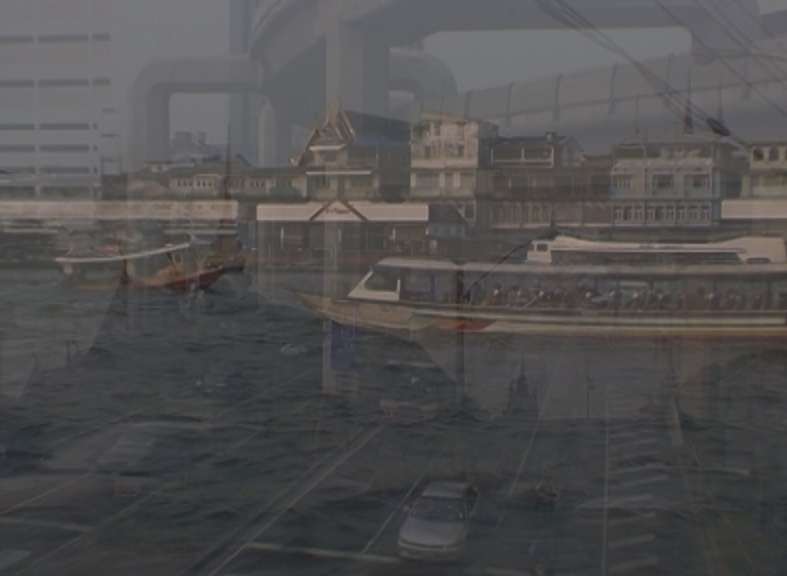
For more information about the MAT Seminar Series, go to: seminar.mat.ucsb.edu.
For previous seminars, please visit our MAT Seminars Video Archive.
Speaker: Haru Hyunkyung Ji
Monday, October 31, 2022 at 1pm via Zoom.

Abstract
Humans have always looked to nature for inspiration. As artists, we have done so in creating a family of “Artificial Natures”: interactive art installations surrounding humans with biologically-inspired complex systems experienced in immersive mixed reality. Through building immersive artificial ecologies, we are questioning how we may coexist with non-human beings in ways that are more abundantly curious, playful, and mutually rewarding. In this talk, from an innate curiosity and aesthetic survival instinct, I will share how we are bringing alternate worlds in superposition to us in order to shatter the perspective of humans as the center of the world and to deepen our understanding of the complex intertwined connections in dynamic living systems.
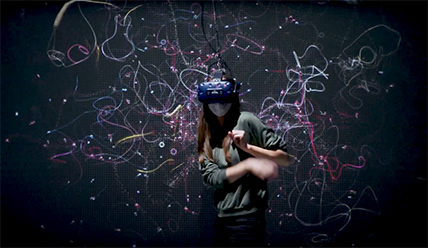
Bio
Haru Hyunkyung JI is a media artist and co-creator of the research project “Artificial Nature”. She holds a Ph.D. in Media Arts and Technology from the University of California Santa Barbara and is an Associate Professor in the Digital Futures, Experimental Animation, and Graduate programs at the OCAD University in Toronto, Canada. She works as jury member for SIGGRAPH Art Papers, ISEA, and SIGCHI DIS and has published articles in Leonardo, Stream04, IEEE Computer Graphics and Applications among others.
Artificial Nature is an installation series and research project by Haru JI and Graham WAKEFIELD, creating a family of interactive art installations surrounding humans with biologically-inspired complex systems experienced in immersive mixed reality. Since 2007, Artificial Nature installations have shown at international venues including La Gaite Lyrique (Paris), ZKM (Karlsruhe), CAFA (Beijing), MOXI and the AlloSphere (Santa Barbara), and City Hall (Seoul, South Korea), festivals such as Microwave (Hong Kong), Currents (Santa Fe), and Digital Art Festival (Taipei), conferences such as SIGGRAPH (Yokohama, Vancouver), ISEA (Singapore), and EvoWorkshops (Tubingen), as well as recognition such as the international 2015 VIDA 16.0 Art & Artificial Life competition and the 2017 Kaleidoscope Virtual Reality showcase.
For more information about the MAT Seminar Series, go to: seminar.mat.ucsb.edu.
For previous seminars, please visit our MAT Seminars Video Archive.
Speaker: Joshua Dickinson
Monday, October 24, 2022 at 1pm PDT. Room 2611 Elings Hall and via Zoom.
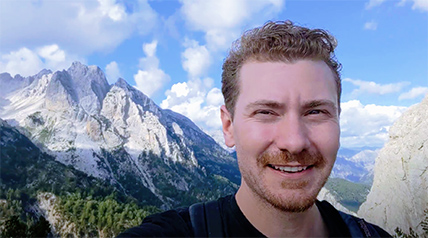
Abstract
In this talk I will show examples of how attempts to simulate and exaggerate the qualities of analog systems have led to new, often unexpected, and unexplored tools for sound design. We will discuss "supernormal stimuli" and hyperreality, and how these concepts can be used as a lens for common sound processing techniques as well as a framework for developing future algorithms. We will cover lesser-known tricks for adding an organic feel into digital systems and what areas seem ripe for future exploration, using examples from our own product line as well as the work of other companies throughout the audio industry. Topics will include new approaches to drum sampling and modeling, vinyl simulation, dynamics processing, neuroaesthetics, analog modeling, non-linearity, and timbral expansion.
Bio
Joshua Dickinson is a founder of Unfiltered Audio, a company specializing in creative audio effects and synthesizers. He is an instructor at Berkeley City College, where he teaches courses on topics such as graphic visualization, HCI, games, and entrepreneurship.
For more information about the MAT Seminar Series, go to: seminar.mat.ucsb.edu.
For previous seminars, please visit our MAT Seminars Video Archive.

Dates: October 13th and 14th, 2022.
October 13th: free performances at 6pm, 7pm, and 8pm.
October 14th: walk-in installation starting at 6pm.
The AlloSphere is located in the California NanoSystems Institute, Elings Hall, on the UCSB campus. The entrance is located on the second floor.
Musics of the Sphere is a spatial audio composition made expressly for the 54.1 channel sound system of the AlloSphere, with no visuals, featuring the unique audio resolution of the instrument. The work is a 57-minute, fixed-media computer music composition in six tracks of spatially modulated sounds. The Allosphere is the perfect venue to present the piece where loudspeakers are placed around and above and below the listeners.
This new work by Dr. Morris is a celebration of "musics" from all over the world. Over 150 excerpts of all types of music from Africa, the Americas, Asia, and Europe comprise the sounds in each track. These "musics" are presented as such (without modification) to partial and complete transformation via a host of computer music techniques.
Bio
Dr. Robert Morris is an internationally known composer and music scholar, having written over 180 compositions including computer and improvisational music and music to be performed out of doors, as well as four books and over 70 articles and reviews. Since 1980, he has taught at the Eastman School of Music, University of Rochester as Professor of Composition and affiliate member of the Theory and Musicology Departments, and at present interim Chair of the Composition Department. His many compositions have been performed in North and South America, Europe, Australia, and Japan. Morris's music is recorded on Albany Records, Attacca, Centaur, Composers Recordings Incorporated, Fanfare, Music and Arts, Music Gallery Editions, New World, Neuma, Open Space, and Renova.
Speaker: Robert Morris
Wednesday, October 12, 2022 PDT. Room 2611 Elings Hall and via Zoom.
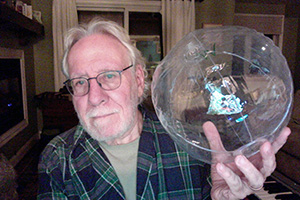
Abstract
I will discuss and describe my new composition, Musics of the Sphere, to be presented in the AlloSphere on Oct 13 and 14, 2022. The work is a 57 minutes-long fixed-media computer music composition in six tracks of spatially modulated sounds. The sounds on each track move between six locations: Up (above) Down (below), North (in front), East (to the right), South (in back), and West (to the left). Therefore, the Allosphere is the perfect venue to present the piece where loudspeakers are placed around the listeners to implement the six spatial locations.
Musics of the Sphere is a celebration of musics from all over the world. Over 150 excerpts of all types of music from Africa, the Americas, Asia, and Europe comprise the sounds in each track. These musics are heard from without modification to complete transformation via a host of computer music techniques. This composition is not the first of mine that uses “world musics.” In 1973, I composed a 45-minute electronic piece in four tracks called Thunder of Spring over distant Mountains. This piece was based on seven pieces of Asian and south-Asian music. The talk I will discuss the differences between Thunder and Musics from three points of view: the technical sound production; the structures of each; and the way each piece implements my thinking about music from a ethnomusical perspective.
Bio
Robert Morris (1943) is an internationally known composer and music scholar, having written over 180 compositions including computer and improvisational music, music to be performed out of doors, four books, and over 70 articles and reviews. Since 1980 he has taught at the Eastman School of Music, University of Rochester as Professor of Composition and affiliate member of the Theory and Musicology Departments, and at present interim Chair of the Composition Department. His many compositions have been performed in North America, Europe, Australia, and Japan. Morris's music is recorded on Albany Records, Attacca, Centaur, Composers Recordings Incorporated, Fanfare, Music and Arts, Music Gallery Editions, New World, Neuma, Open Space, and Renova.
For more information about the MAT Seminar Series, go to: seminar.mat.ucsb.edu.
For previous seminars, please visit our MAT Seminars Video Archive.
Speaker: Bettina Forget
Monday, October 3, 2022, at 1pm PDT via Zoom
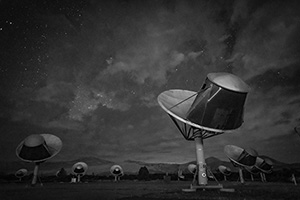
Abstract
Are we alone in the universe? This is the existential question at the heart of the SETI Institute’s research - both for its scientists as well as for the artists in its AIR program. Bettina Forget will discuss various modes of engagement between art, science, and technology by showcasing a selection of projects across the disciplines of new media arts, performance, AI, and storytelling.
Bio
Bettina Forget is the Director of the SETI Institute’s Artist-in-Residence (AIR) program. Her creative practice and academic research examine the re-contextualization of art and science, and how transdisciplinary education may disrupt gender stereotypes. Bettina works with traditional as well a new media arts, focusing on astrobiology, sci-fi, and feminism.
For more information about the MAT Seminar Series, go to: seminar.mat.ucsb.edu.
For previous seminars, please visit our MAT Seminars Video Archive.
Speaker: Jelani Nelson
Monday, September 26th, 2022 at 1pm PDT via Zoom.
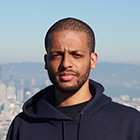
Abstract
Many of us use smartphones and rely on tools like auto-complete and spelling auto-correct to make using these devices more pleasant, but building these tools creates a conundrum. On the one hand, the machine-learning algorithms used to provide these features require data to learn from, but on the other hand, who among us is willing to send a carbon copy of all our text messages to device manufacturers to provide that data? In this talk, we show a surprising paradox discovered roughly 20 years ago: it is possible to learn from user data in the aggregate, while mathematically provably maintaining privacy at the individual level. We then present a recent private mechanism of our own for this task, based on projective geometry (popularized by Brunelleschi during the Italian Renaissance). This talk is based on joint work with Vitaly Feldman (Apple), Huy Le Nguyen (Northeastern), and Kunal Talwar (Apple).
Bio
Jelani Nelson is a Professor in the Department of Electrical Engineering and Computer Sciences at UC Berkeley, and also a part-time Research Scientist at Google. His research interests include sketching and streaming algorithms, random projections and their applications to randomized linear algebra and compressed sensing, and differential privacy. He is a recipient of the Presidential Early Career Award for Scientists and Engineers, a Sloan Research Fellowship, and Best Paper Awards at PODS 2010 and 2022. He is also Founder and President of AddisCoder, Inc., which has provided free algorithms training to over 500 Ethiopian high school students since 2011, and which is co-launching a similar "JamCoders" program in Kingston, Jamaica in Summer 2022.
For more information about the MAT Seminar Series, go to: seminar.mat.ucsb.edu.
For previous seminars, please visit our MAT Seminars Video Archive.
Pilar Wiley and Avi Farber, our 2022 Experimental Clay artists in residence, will be talking about their work. Pilar and Avi will share their earlier work, as well as some details about the work they have undertaken in our lab and the opportunities and limitations they see for digital fabrication within their practice.
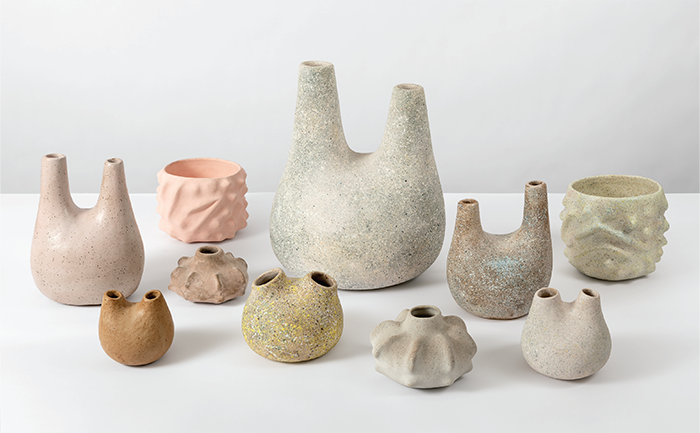
Pilar Wiley
Los Angeles-based Pilar Wiley makes ceramic vessels that serve as canvases for her repeating patterns and pictorial themes. Her surfaces express the idiosyncrasies of mark making, referencing global traditions of decorative abstraction, as well as imagery drawn from plant life and her childhood overseas. Influenced by the forms and techniques of West and South African pottery, Wiley advances a personal mythology through the repetitive ceramic process. Capitalizing on clay’s ritualistic associations, she endeavors to transform the information she consumes.
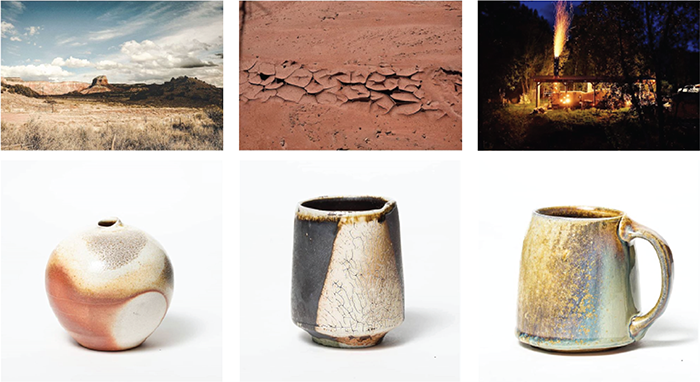
Avi Farber
Avi Farber is a multimedia artist working with woodfired ceramics, documentary photography, 3D Printing, and new media/sound, based in New Mexico, U.S.A. After earning a degree in Philosophy at Bates College, ME, Avi took a job fighting wildfires for the United States Forest Service. This inspired a large body of documentary work as well insights that led him to pursue a Masters degree in Interdisciplinary Design at Emily Carr University of Art and Design (2021).
Working in clay, Avi creates installations, sculptures, and functional wares that explore landscapes and weathering. Working with local clays and firing with wood, his work is raw and refined, subtle and gestural. Drawn to the moments that break through the distractions of daily life, Avi documents people in environmental frontiers. His photos, video, and sound installations reveal a strong sense of place as seen from a quiet observer. His projects explore human relationships with the natural phenomenon of our changing climate and alternative modes of production.
For more information, please visit ecl.mat.ucsb.edu/artisttalks
The Expressive Computation Lab at UCSB
The Santa Barbara Center for Art, Science and Technology (SBCAST)
Friday, July 8, 2022 at 1pm PDT.
Room 1605 Elings Hall and via Zoom.
Abstract
Soft robotics technologies hold substantial promise for use in wearable haptic systems, due to their ability to supply forces to the human body in a compliant, conformal, and safe manner. A challenge at the intersection of soft robotics and wearable haptics is to seamlessly integrate soft components into garments. The overarching goal of my Ph.D. research is to transform textiles into soft robotic haptic garments that are comfortable, ergonomic, and can provide multimodal, affective, and expressive haptic feedback tailored to the human sense of touch. This PhD integrates research on the design, fabrication, and control methods for soft robotic textiles. It contributes new methods for expressive haptic feedback for large areas of the body, and guidelines for the design of haptic feedback delivered via garments, accounting for immersion, emotion, affect, and health-related benefits. This dissertation contributes to the fidelity, ubiquity, and social relevance of wearable haptic systems, by allowing haptics to be seamlessly integrated within garments that are widely used.
The first part of this dissertation reviews emerging advances in soft wearable robotic and haptic technologies, and several promising application areas, including wearable haptic interfaces, assistive robotics, and biomedical devices [1]. It summarizes essential design considerations for such systems based on functional concerns, wearability, and ergonomics. It provides a synthetic review of design strategies that have been adopted in numerous examples from prior research by surveying sensing and actuation technologies, materials, and fabrication methods. The chapter concludes with a discussion of frontiers, challenges, and future prospects for soft, wearable robotics. These findings guided the development of novel wearable technologies and haptic rendering methods in the following parts of the thesis.
The second part of this dissertation presents the development of a new family of soft actuators that are suitable, versatile, and effective for wearable applications. We refer to these actuators as fluidic fabric muscle sheets (FFMS) [2]. These sheet-like actuators can strain, squeeze, bend, and conform to the human body. I designed and fabricated FFMS using fabrics and elastic tubes through facile apparel engineering methods. Though the fabrication process is low-cost and straightforward, FFMS can operate at frequencies of 5 Hz or more, achieve engineering strains exceeding 100%, and exert forces exceeding their weight by more than 10,000%. I further demonstrated several potential use cases of FFMS actuators, including a miniature steerable robot, a glove for grasp assistance, garments for applying compression to the extremities, and devices for actuating small body regions or tissues via localized skin stretch.
The next part of this dissertation demonstrates how FFMS actuators can be used to realize a wearable haptic interface with integrated sensing and multimodal actuation. Using six FFMS actuators, I constructed a forearm sleeve called the PneuSleeve [3]. It is able to render a broad range of haptic feedback types including compression, skin stretch, and vibration, and is able to supply consistent feedback to users with different arm sizes and anatomies by virtue of integrated soft capacitive sensors and a closed-loop force controller. Physical characterizations showed that the actuators generated consistent and perceivable forces at frequencies of 20 Hz, as validated in engineering characterizations. Results of user studies highlight the expressiveness of the haptic effects it provides. The PneuSleeve holds the potential for enabling new interfaces, haptic notifications, navigation, gaming, AR/VR experiences, and many other applications.
In the final part of this dissertation, informed by the preceding results, I designed and investigated a peristaltic soft robotic sleeve for supplying dynamic compression therapy via finger-sized FFMS actuators [4]. The sleeve can produce dynamic compression pressure exceeding 22 kPa at frequencies of 14 Hz or more, meeting the requirements for compression therapy and massage. An array of software-programmable peristaltic compression patterns can be furnished by varying frequency, amplitude, phase delay, and duration parameters. To evaluate the promise this sleeve holds for aiding peripheral hemodynamic flow, I designed a mechanical fixture integrating artificial muscles, skin, and a vein, modeled after the human upper limb. Results showed that the wearable robot was capable of driving fluid flow at rates of up to 1 mL/min. The results matched theoretically derived predictions for peristaltic fluid transport. This dynamic compression garment holds promise for treating disorders affecting lymphatic and blood circulation.
Wednesday June 8th, 2022 at 3pm PDT.
Experimental Visualizaton Lab (room 2611 Elings Hall) and via Zoom.
Abstract
Assemblage is an artistic practice where found or unrelated objects and different materials are juxtaposed to result in new entities, which often suggest non-linear narratives, poetic meanings, and new symbols. The ideas and methods of assemblage widely emerged during the early twentieth century in the early stages of modernism and were closely connected to modern art movements such as Cubism, Surrealism, and Dada. Nowadays, images are programmable databases that are increasingly networked with the advent of operative images and machinic vision, offering new ways to conceptualize assemblages based on authorship, connectivity, data-driven forms, materials, and chance and choice operations. In the field of new media art, few interactive artificial intelligent visual works address the changing notion of images through assembling image data as a real-time generative experience that emphasizes collective voices from artists, intelligent machines, and participants. In this context, I conduct practice-based research and propose a methodology for A Speculative Assemblage: transform the image-making process into a real-time visual experience in an artist-machine-participants collaborative manner.
A Speculative Assemblage proposes interdisciplinary and critical design research, which is at the intersection of experimental visualization, interactive AI art, and immersive media design. This research is demonstrated through three core interactive AI artworks (Cangjie's Poetry, LAVIN, and RAY), along with preliminary research: five image-based immersive art projects ( Fantastic Shredder, Repository, Borrowed Scenery, Astro, and Volume of Voids ). A novel design methodology and conceptual framework are presented to integrate intersections of the real and the virtual through the current methods to engage machine vision in relation to human perception and the impact of automation on originality.
Monday June 6th, 2022. 12pm PDT.
MAT Conference Room (2003 Elings Hall) and via Zoom.
Abstract
Along with the increasing digitization of society, our personal data has been explicitly or implicitly collected and shared through a plethora of digital devices and online social media services. This personal data has become of vital importance for researchers, designers, and artists to represent an impression of our datafied society and depict the images of data subjects through various forms of data representations. Meanwhile, the explosive increase of personal data has also been accelerated by commercial or governmental entities behind services or technology to monetize the customer data or surveil citizens. For that, the data is used to categorize or predict our behavior, preference, and identity through machines, for example, content recommendation and face recognition.
As our society is increasingly datafied, we see ourselves through our data for self-representation and self-understanding, which is collected and processed by the machines. Moreover, responses from the machines also affect us in shaping our behavior and understanding ourselves. Within this data-centered human-machine interrelationship, the Human-Data-Machine Loop, the machines see us through available, measurable data obtained from us and see us through stochastic, algorithmic processes to generalize individuals. Here uncertainty exists because personal data is not an objective representation of oneself and the machines are not perfect; they can be erroneous and biased upon the data or humans. These issues of uncertainty are difficult to estimate and represent, and they are problems to be solved especially in scientific domains. But, this uncertainty perspective can be a creative force or theme in data art. This dissertation proposes artistic approaches to represent this nature of uncertainty in the Human-Data-Machine Loop through data art. To this end, I first define the Human-Data-Machine (HDM) Loop as a main conceptual research framework to view our datafied society along with possible types/sources of uncertainty in the Loop. Second, I propose three types of data art practice based on the HDM framework: Artist-centered Practice, Artist-Machine Collaborative Practice, and Machine-centered Generative Practice. Last, the dissertation explains the author’s data-driven audiovisual art projects as an empirical case study of each data art practice. This dissertation aims to contribute to expanding data art practice with the perspective of uncertainty in data practice and raising concerns about uncertainty in our datafied society through artistic approaches.
Masaki Fujihata is one of the pioneers of Japanese new media art, beginning his career working in video and digital imaging in the early 80s. As an early practitioner of the application of new technologies to the process of artmaking, he was one of the first artists to use stereolithography, a technique in which a laser polymerizes a liquid resin as it sweeps its surface. He also created the worlds smallest sculptures by using the manufacturing techniques for integrated circuits (at 10m and 100m, these works are visible only with an electron microscope). However, he is most recognized for his sophisticated interactive network installations and his primary concern has been to employ multimedia technology in order to examine the possibilities for communication within virtual spaces. His new work BE HERE/1942 is currently being exhibited at the Japanese American National Museum in Los Angeles.
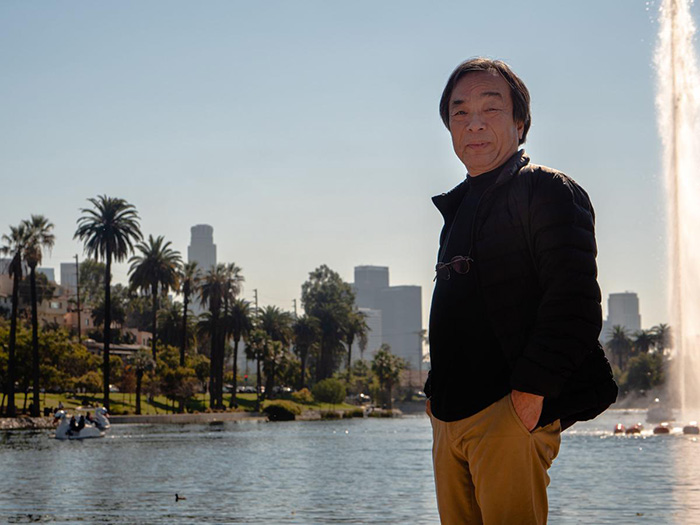
Masaki Fujihata at Echo Park, Los Angeles. Photo by David Leonard.
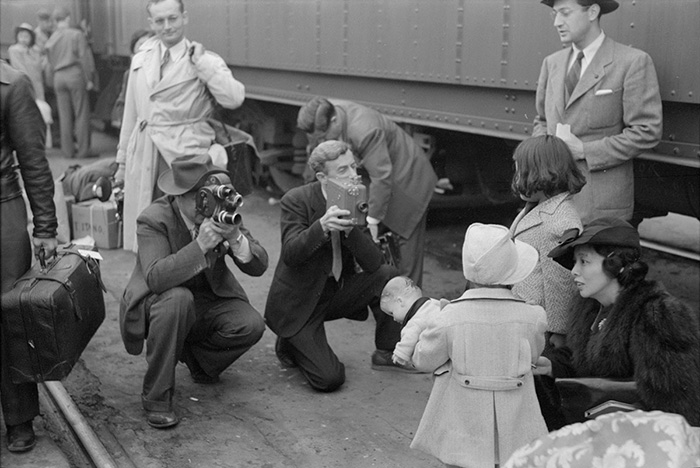
Photo from BeHere/1942 exhibit: Two young girls being filmed as they wait to board a train that will take them to Owens Valley (Manzanar). Photograph by Russell Lee, Los Angeles, California, April 1942. Courtesy of the Library of Congress, loc.gov/resource/fsa.8a31184.
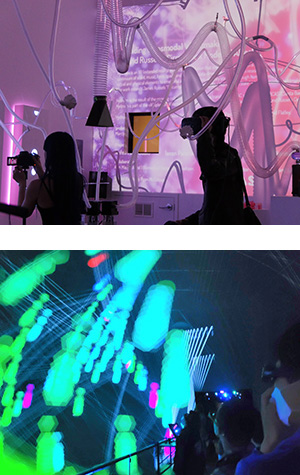
SYMADES (Start of the Year Media Arts Design Engineering and Science) was held on the following dates:
At the event at SBCAST, MAT was pleased to present a guest performance of Song Cycle, first premiered on April 9, 2022 at the Los Angeles Philharmonic. Song Cycle is an immersive performance that describes an emergent world of music, or all the music that could ever happen. The text is randomly generated as a work of process poetry and is set within a texture of mystic drones, the sound of the rain pressed into vinyl, early drum machines, and generous harmonies accompanied by an evolving floral arrangement. Song Cycle is performed by the loose ambient collective superteam and florist Alexandra Rose Franco. The performance is a collaboration between artists Chris Kallmyer and Zoe Aja Moore.
MAT's very own Curtis Roads also performed his piece Always (2013), with visualisation art by Brian O'Reilly (MAT alum).
Both performances were supported by the Systemics Public Events fund and private donors.
MAT is grateful to Alan Macy for his support and generous use of SBCAST in downtown Santa Barbara.

Performance of Always by Curtis Roads at SBCAST. Visualizations by Brian O'Reilly.
Projection mapping by the transLAB.
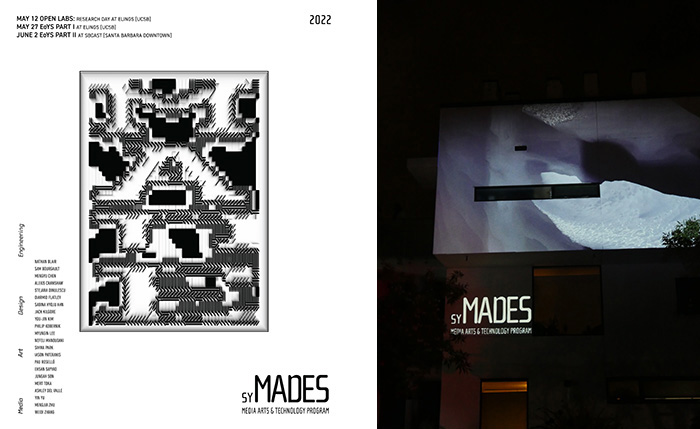
Thursday, June 2nd, 2022
12:00pm (Santa Barbara) / 9:00pm (Berlin) via Zoom
Abstract
In 1958, Iannis Xenakis used a glissandi diagram as the parti for the architectural design of the Philips Pavilion. It was a pioneering example of an architectural form directly derived from the morphology of a sound object. In stark contrast, sound is usually seen as a pollutant, as something to be absorbed, blocked, and diffused in current architectural design and practice. From an architectural design theory perspective, Digital Morphogenesis demonstrates significant theoretical implications in computational design and digital fabrication due to its natural-inspired sustainable methodologies, new forms, fabrication techniques, and multidisciplinary approaches. However, our current architectural and design field does not consider sound material from a morphological perspective in both theory and practice.
My research aims to expand the theory of digital morphogenesis by encompassing sound objects as additional architectural material for computational design and fabrication. I introduce Sound Morphogenesis Design (SMD), a new design framework that uses information theory as a foundation to develop methodologies for architecture and design research. My research explores three main questions: (1) How does architectural practice change when sound is not viewed as pollution but as a design opportunity? (2) How does sound morphology expand the theory of digital morphogenesis and change the approach for architectural design research? And (3) what would be the novel design practice of sound morphogenesis design that enhances aural experiences and aesthetics? By integrating sound morphology in design, this dissertation presents a systematic survey of musical aesthetics in architectural projects and develops two SMD methodologies: WYHIWYW and SoftTectonics. WYHIWYW (What You Hear Is What You Wear) investigates digital domain design techniques such as Digital Design through the Open-Sound-Control Protocol, Computational Design through MIDI, and Computational Design through Modular Synthesizers. Through such techniques, the listening experience enriches and expands the design process. SoftTectonics explores sound morphogenesis from three different approaches using physical prototyping of soft materials: tip-grow, feather-flip, and pneumatic-cavity. SMD methods provide a framework for digital architecture, wearable design, and new media artworks. A novel analysis tool CIMT (Creative-Impact-Musicality-Technology) evaluates the developed research experiments to prove SMD’s contribution as a design theory. The present dissertation paves a path to cross music and architecture for future discovery, design, and human perception.
Speaker: Christina Naomi Tague
Monday, May 16th 2022, at 1pm PDT via Zoom
Abstract
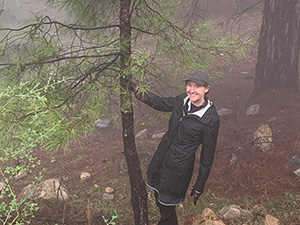
As climate warms, the complex interactions between forests and water also change - and these changes can transform our landscapes. In the Western US, we have already seen increased fire severity, drought, floods, and widespread forest mortality.
Naomi's TagueTeamLab develops a widely used mechanistic model, RHESSys, that simulates interactions among water, carbon, soils and vegetation at scales from a forest plot to a watershed- We use this model to understand our changing landscapes and to predict future changes. Recently she has been collaborating with an artist, Ethan Turpin, and MAT graduate, David Gordon, to translate the data generated by RHESSys into meaningful visualization that can help the public, students and scientists themselves explore how water-trees and climate coevolve. This talk will present this work - and talk about possible future directions.
Bio
Christina Tague's research is focused on the interactions between hydrology and ecosystem processes and, specifically, how eco-hydrologic systems are altered by changes in land use and climate. Much of her work involves developing and using spatial simulation models to integrate data from multiple field-based monitoring studies in order to generalize results to larger watersheds. Reflecting that emphasis, she is one of the principal developers of the Regional Hydro-Ecologic Simulation System (RHESSys), an integrated model of spatially distributed carbon, water, and nitrogen cycling. RHESSys is designed to provide science-based information about spatial patterns of ecosystem health and vulnerability in terms of water quantity and quality. Professor Tague is currently modeling the impacts of climate change on stream-flow patterns in the western United States and examining how urbanization alters drainage patterns and associated biogeochemical cycling in watersheds in Baltimore, Maryland, and Southern California.
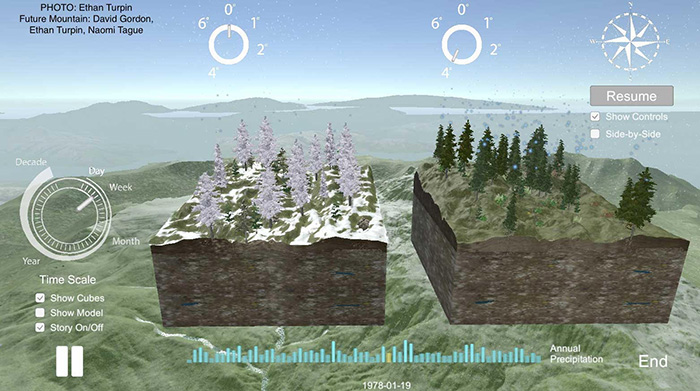
www.geog.ucsb.edu/people/faculty/christina-naomi-tague
For more information about the MAT Seminar Series, go to: seminar.mat.ucsb.edu.
For previous seminars, please visit our MAT Seminars Video Archive.
Speaker: Felecia Davis
Monday, May 16th 2022, at 1pm PDT via Zoom.
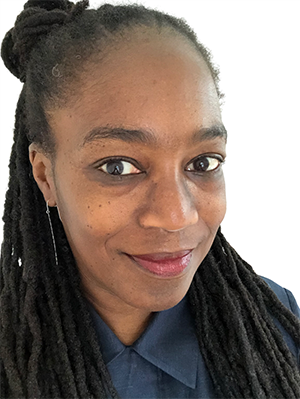
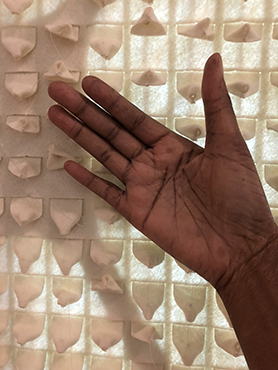
Abstract
Touch of a computational textile on human skin provides a unique opportunity to look at relationships between ambience, emotion and computing. The sense of touch on human skin offers a potential framework to think about ambient computing as the information from skin is multimodal and comes in many forms such as temperature, humidity, sharpness, smoothness, location and movement. Because textiles surround and shelter people in every culture on the planet, they are a culturally embedded and potentially invisible way to create interfaces for people to capture or receive information in ways that engage other senses such as touch. The author of this talk will share work that examines communication of emotion by touch and implications for design computing.
Bio
Felecia Davis’ work in computational textiles questions how we live and she re-imagines how we might use textiles in our daily lives and in architecture. Davis is an Associate Professor at the Stuckeman Center for Design Computing in the School of Architecture at Pennsylvania State University and is the director of SOFTLAB@PSU. She completed her PhD in Design Computation at MIT. Davis’ work in architecture connects art, science, engineering and design and was featured by PBS in the Women in Science Profiles series. Davis’ work was part of the MoMA’s exhibition Reconstruction: Blackness and Architecture in America. She is a founding member of the Black Reconstruction Collective a not-for-profit group of Black architects, scholars and artists supporting design work about the Black diaspora. Davis’ work has been recently recognized by the New York Architectural Leagues’ 2022 Emerging Voices in Architecture program.
www.blackreconstructioncollective.org
For more information about the MAT Seminar Series, go to: seminar.mat.ucsb.edu.
For previous seminars, please visit our MAT Seminars Video Archive.
Speaker: Yasaman Sheri
Monday, May 9th, 2022 at 1pm PDT via Zoom.
Abstract
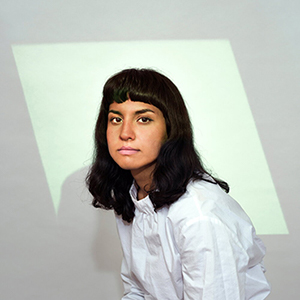
2020 marked an entry into a new era signifying a powerful moment to support aesthetic and political engagements in life sciences and ecology. With rapid advances made in biotechnologies and instruments in perception & sensing technology, artists and designers are an increasingly important voice in shaping how such technologies get rendered at societal level. From ecological awareness around climate change, ethics of geo-engineering, creation of sensing systems, providing glimpses into techno-biological futures, to making with a multitude of species and living systems, the creative inquiry explores the poetic entanglements of living systems & contextualizes conceptually our everyday living. This talk explores sheri’s on-going research & investigation in life sciences through artistic intervention & critical inquiry.
Bio
Yasaman Sheri is a Design Director, Artist & Researcher investigating human relationship to biology & technology and the creative inquiry into life sciences. Her artistic and critical practice explores the plurality of senses and sensing, perception and the invisible scales at which humans frame and reframe ecology through culture, society and technology. She is the founder and Principal Investigator of Serpentine Galleries Synthetic Ecologies Lab and also an educator and design leader with more than a decade of experience in building platforms and novel interfaces in mixed reality and immersive computing as well as life sciences. Yasaman is passionate about sharing her expertise and continues to uplift women identifying communities of color and folks less represented.
For more information about the MAT Seminar Series, go to: seminar.mat.ucsb.edu.
For previous seminars, please visit our MAT Seminars Video Archive.
Speaker: Memo Akten
Monday, May 2nd 2022, at 1pm PDT, ExpVisLab (room 2611) Elings Hall and via Zoom.
Abstract
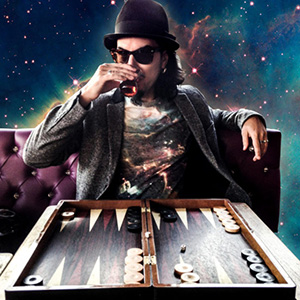
In this talk, Memo discusses the conceptual motivations behind some of his recent works and research involving computational technologies, with a focus on artificial intelligence and machine learning, embodied interaction, and mixed reality. From a practical perspective, this includes explorations in real-time, interactive computational systems for artistic, creative expression; and 'intelligent' systems for human-machine collaborative creativity. From a more conceptual perspective, this involves investigations into how we make sense of the world and project meaning onto noise; and more broadly speaking, the collisions between nature, science, technology, ethics, ritual, tradition and religion; particularly in the context of the current social and political polarizations, moral crises and technological submission.
Bio
Memo Akten is a multi-disciplinary artist, experimental filmmaker, musician and computer scientist from Istanbul, Turkey. He works with emerging technologies and computation as a medium, to create images, sounds, films, large-scale responsive installations and performances. Fascinated by trying to understand the nature of nature and the human condition, he draws from fields such as biological and artificial intelligence, computational creativity, consciousness, neuroscience, physics, biology, ecology, philosophy, ritual and religion. He has a PhD in Artificial Intelligence and expressive human-machine interaction from Goldsmiths University of London, and is Assistant Professor of Computational / New Media Art at University of California, San Diego (UCSD). Akten is a frequent keynote speaker on topics involving art, science, technology and culture. As part of his PhD, he specializes in expressive human-machine interaction and creative explorations of Artificial Intelligence, and in this field he is considered one of the world’s leading pioneers.
For more information about the MAT Seminar Series, go to: seminar.mat.ucsb.edu.
For previous seminars, please visit our MAT Seminars Video Archive.
Speaker: Warren Sack
Monday, April 25th, 2022 at 1pm PDT via Zoom
Abstract
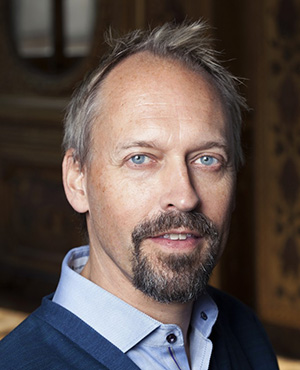
Miniatures, demos and artworks (MDAs) are three kinds of software produced in universities, research laboratories, and the art world. Primarily they are created for teaching, arguing, selling, and sparking the imagination to show a larger public what is possible for the future of software. The most well-known miniature is Minix developed by Andrew Tanenbaum (Vrije Universiteit Amsterdam) to teach students about the workings of the Unix. “The mother of all demos” was produced in 1968 by Douglas Engelbart (SRI) introducing the computer mouse, resizable windows, teleconferencing, hypertext, word processing, and collaborative editing — and basically everything we have today in personal computing. The best-known software artwork is probably Spacewar!, a computer game created by Steve Russell in collaboration with several others at MIT in 1962. In this talk I will describe how MDAs are similar and different from one another, have been used and abused in imagining the future of software. Examples include those from the Yale AI Project of the 1980s (where the design of miniatures was a vital concern); demos from the MIT Media Laboratory of the 1990s (an agonistic environment of “demo or die”); and contemporary artworks from the Whitney Museum of American Art, NYC.
Bio
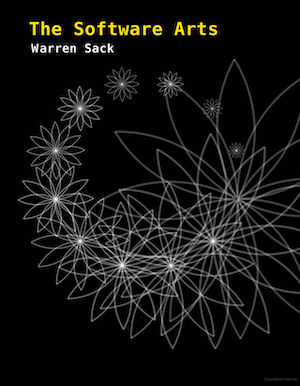
Warren Sack is a media theorist, software designer, and artist whose work explores theories and designs for online public space and public discussion. He is Professor of the Software Arts in the Film + Digital Media Department at the University of California, Santa Cruz where he teaches digital arts and digital studies. He has been a visiting professor in France at Sciences Po, the Fondation Maison des sciences de l'homme, and Télécom ParisTech. His artwork has been exhibited by SFMoMA (San Francisco), the Whitney Museum of American Art (New York), the New Museum of Contemporary Art (New York), the Walker Art Center (Minneapolis), and the ZKM (Karlsruhe, Germany). His scholarship and research has been supported by the Paris Institute for Advanced Study, the American Council of Learned Societies, the Sunlight Foundation, and the National Science Foundation. Warren received his PhD from the MIT Media Lab and was an undergraduate at Yale College.
More about his 2019 book, The Software Arts (MIT Press) can be found at http://softwarearts.info.
For more information about the MAT Seminar Series, go to: seminar.mat.ucsb.edu.
For previous seminars, please visit our MAT Seminars Video Archive.
Tuesday April 19th at 6pm PDT. Studio Xenakis (Music 2215)

This talk is an introduction to the New Pulsar Generator (nuPG) program. Developed in SuperCollider 3 programming language and using the SuperCollider Server for sound synthesis, nuPG builds upon and extends historical Pulsar Generator (2001) by Curtis Roads and Alberto de Campo. After a brief overview of the program design, the key objective of the talk is to demonstrate a set of formal methods developed by Marcin Pietruszewski as part of his compositional praxis. This includes techniques of sieves, per-pulsar processing, and pulsar- wavelet transform are discussed. The nuPG program offers an established visual mode of data representation and editing. It also provides a text-based (live coding) extension enabling a fast implementation of new algorithmic processes. As a prelude to this talk, the composer encourages the audience to learn about fundamental notions of pulsar synthesis as described in Microsound by Curtis Roads.
Marcin Pietruszewski (b. 1984, Poland) is a composer and researcher. He is engaged in sound synthesis and composition with computers, exploring formal developments in the tradition of electroacoustic music and contemporary sound art. He works across composition, installation, and radio production. Works exhibited at West Court Gallery (Edinburgh, 2019), Remote Viewing (Philadelphia, 2019), and Institute of Contemporary Arts (London, 2017). Commissions by CTM Festival (2021), ZKM Karlsruhe (2018) and Deutschlandradio Kultur (2016). As an educator, Marcin has given courses focused on digital instrument design, digital signal processing, sound theory, and practice. He has taught at The Reid School of Music (Edinburgh College of Art) and Design Informatics (The University of Edinburgh). He also writes on issues related to computer music histories, aesthetics, and technology. His texts have been published by Hatje Cantz and ZKM among others. Currently, Marcin is a Research Fellow in the Department of Computer and Information Sciences of Northumbria University, Newcastle. Marcin lives and works in Berlin.
Speaker: Ekene Ijeoma
Monday, April 18th, 2022 at 1pm PDT via Zoom.
Abstract

Ekene will share how he works across his studio and lab practices to address social issues through various mediums and scales.
Bio
Ekene Ijeoma is an artist who focuses on the overlooked or shared aspects of sociopolitical trends and interpersonal dynamics through the lenses of personal observation and analytical exploration. He works across various mediums including sound, video, sculpture, installation, and performance.
His work has been exhibited and performed at Bemis Center for Contemporary Art (2021), Contemporary Art Museum of St. Louis (2021), Museum of Contemporary Art Denver (2020), Contemporary Art Museum of Houston (2020), The Kennedy Center (2019, 2017), Museum of the City of New York (2019, 2018), Neuberger Museum of Art (2016), Storefront for Art and Architecture (2015) and Museum of Modern Art (2015) among others.
His practice has been supported by grants and fellowships, including The New York State Council on the Arts (2021); Creative Capital (2019); Map Fund (2019); The Kennedy Center (2017); and New York Foundation for the Arts (2016) among others.
Ijeoma is a first-generation Nigerian-American born and raised in Fort Worth, TX. He lives and works between his studio in Brooklyn, NY, and lab in Cambridge, MA. He earned his BS in Information Technology at Rochester Institute of Technology in 2006 and MA in Interaction Design from Domus Academy (Milan, IT) in 2008. He is an Assistant Professor of Media Arts and Sciences at Massachusetts Institute of Technology and the Founder and Director of the Poetic Justice Group at Media Lab. Currently, his work with Poetic Justice Group focuses on how art can address the scale of sociopolitical issues through multisite participatory public artworks. These works are accessible over the phone, online, and soon on the streets.
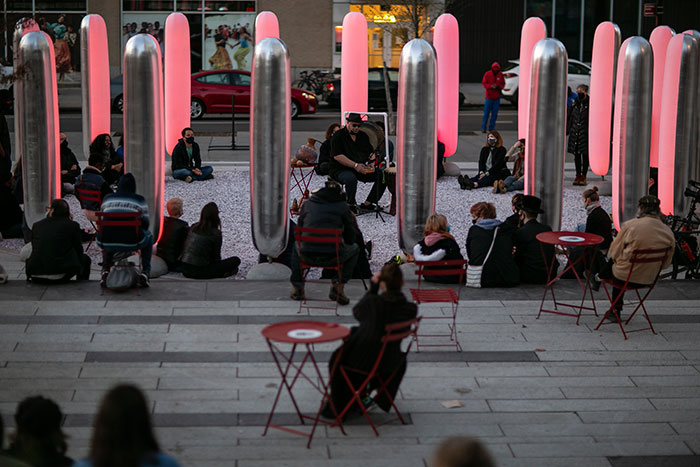
Photo: Kris Graves
For more information about the MAT Seminar Series, go to: seminar.mat.ucsb.edu.
For previous seminars, please visit our MAT Seminars Video Archive.
Speaker: Scott Snibbe
Monday, April 11, 2022 at 1pm PDT, Experimental Visualization Lab (room 2611) Elings Hall and via Zoom.
Abstract
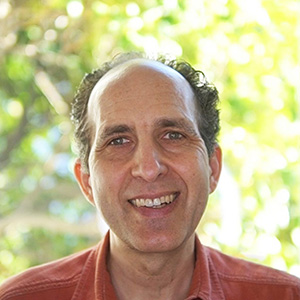
Scott Snibbe will talk about three decades of interactive art that connect people through augmented reality, interactive apps, and embodied social interaction. He’ll touch on the uneasy adoption of interactive art techniques into corporate products, and the way digital art can connect us to others, help us better know ourselves, and even respect respecting privacy in the age of the surveillance state.
Bio
Scott Snibbe is a pioneering interactive artist, augmented reality entrepreneur and the host of the meditation podcast A Skeptic’s Path to Enlightenment. Snibbe’s interactive art installations have been incorporated into concert tours, museums, and airports; and he has collaborated with musicians and filmmakers including Björk, Philip Glass, Beck, and James Cameron. His work can be found in the collections of New York MoMA, the Whitney Museum of American Art, and other institutions. Snibbe has produced several bestselling mobile apps including Gravilux and the world's first “app album” Björk: Biophilia, and was one of the early creators of the special effects animation software Adobe After Effects.
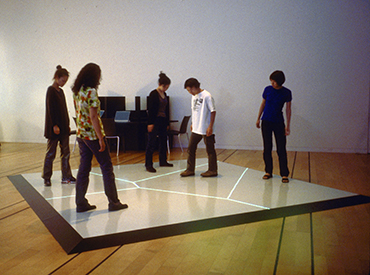
For more information about the MAT Seminar Series, go to: seminar.mat.ucsb.edu.
For previous seminars, please visit our MAT Seminars Video Archive.
Speaker: Marcella Del Signore
Monday, April 4th at 1pm PST via Zoom
Abstract
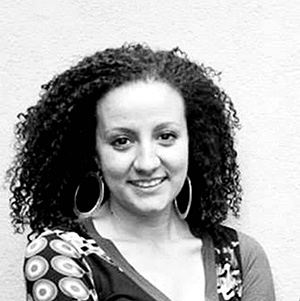
The exploration of the public domain is an important parameter to define how we live as collective and how we can rethink the fundamentals of living. The public realm is an expanded field where the deployment of collective ecologies is inherently connected to the socio-cultural production of space and forms of cohabitation of living systems. The talk addresses the intersection of technologies with the public/social/cultural realm through prototyping, material and fabricated systems, data-driven protocols, and mediated environments. Starting from Aério, an installation recently exhibited at the 17th Venice Architecture Biennale, a series of projects will be the vehicle to speculate on the current and future states of socio-technical apparatuses, interlaced ecosystems, and planetary entanglements.
Bio

Marcella Del Signore is an architect, urbanist, educator, scholar, and the principal of X-Topia, a design-research practice that explores the intersection of architecture and urbanism with technology and the public, social and cultural realm. She is an Associate Professor and Director of the MS. in Architecture, Urban Design at New York Institute of Technology, School of Architecture and Design. Her research focuses on interscalar design approaches that engage the notion of socio-technical systems through computation, prototyping, material and fabricated assemblies, data-driven protocols, and adaptive environments. Her work investigates architecture, environments, and cities not as isolated entities but as part of an extended field mediated through the discursive application of technology. In her design practice, she has built a wide array of urban interventions and small-scale prototypes recognized through awards, grants, and publications. In 2018, she co-curated the ‘Data & Matter’ exhibition at the ECC during the 2018 Venice Architecture Biennale, and in 2021 she exhibited “Aério” at the 17th Venice Architecture Biennale. She also exhibited her work at the Gardiner Museum, Ogden Museum of Southern Art, MIT Media Lab, Columbia University Buell Center, Rotterdam Biennale of Architecture, Arte Sella, Milan Design Week, Zero1 Biennal, Brooklyn Navy Yard, Duncan Plaza, Architekturzentrum Wien, EME3, and a series of festivals including LunaFete, Urban Prototyping, DesCours, Think Town, Northern Spark, Verdecoprente, and Conflux among others.
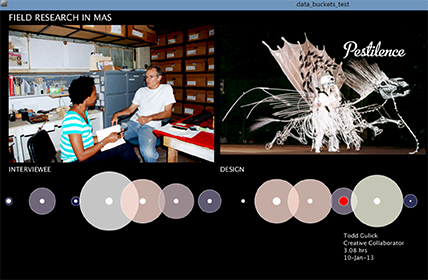
For more information about the MAT Seminar Series, go to: seminar.mat.ucsb.edu.
For previous seminars, please visit our MAT Seminars Video Archive.
Tuesday, March 15th, 2022
2pm PST, transLAB (room 2615), Elings Hall
Abstract
Paideia, a Classical ancient Greek notion of education, encompassed both holistic formal instruction and art (particularly poetry) as means to develop cultural values and understanding. This dissertation examines how the new media arts—as a transdisciplinary and computational field—can be leveraged to fulfill a contemporary notion of paideia in both its practice and instruction, demonstrated through respective artistic and pedagogical proofs-of-concept. Specifically, we analyze the ways in which the computational platform can facilitate the creation and readability of causal relationships across information to embody value, meaning, and holistic thought. To start, we examine how we design affordances—formal qualities that constrain an object’s possible uses by an agent—for guiding participant behavior (observed or enacted) and interpreting meaning as part of experiential learning. We will achieve this through artistic installations and objects. Next, we discuss pedagogical strategies with a cross-disciplinary conceptual framework to support holistic thinking through digital design-based learning. We compare these new efforts toward paideia with ancient Greek media and approaches.
Toward imparting values, the cybernetic nature of physical computing and other interactive systems offer a means to model or to incentivize (and thus train for) certain kinds of participant actions and behaviors. We present an original body of performance and installation work designed to cultivate the values of social cooperation and attention to nuance.
Toward shaping meaning, we propose that complex non-verbal ideas may be communicated by strategic formal design that 1) follows “natural [somatic] mappings” or culturally established associations and/or 2) explicitly defies them, directing attention through “strangeness.” To this end, through a theoretical framework and artistic proofs-of-concept, we explore how computation facilitates abstraction and metaphor via operations of mapping, analysis, and execution.
Lastly, to promote trans-paradigmatic thinking, media arts education and practice through fictional worldmaking can provide a means for organizing complex knowledge and systems. We discuss conceptual framework contributions within the THEMAS (STEAM + creative Humanities) pedagogical model (as originally conceptualized by Marcos Novak).
In these ways, building upon ancient roots, this research both informs the field of media arts and technology and informs education through design strategies for (artistic) experiential and making-based learning.
Monday, March 14th, 2022
10am PST via Zoom
Abstract
Digital fabrication is a rich space for creative production. Many computational tools, including those that support automation, precision, generativity, and parameterization, have been developed to support creativity in fabrication. Emerging digital fabrication tools hold the potential to further expand practices and experiences in digital fabrication, by facilitating more fluid, interactive, and experiential forms of making, in ways that may resemble tools for dynamic digital drawing or real-time audiovisual performance.
However, digital fabrication involves physical materials that introduce constraints that are not present in creative processes involving strictly digital media. For example, creative digital fabrication practices are constrained by the substantial fabrication times that are required. New technologies, tools, and workflows that circumvent such challenges could enable new forms of making, and expand expressive opportunities for creation, by allowing makers to engage more fluidly and interactively with machines and with physical media.
This dissertation investigates this emerging space of opportunity through three key questions: (1) How do current digital fabrication workflows support or constrain aspects of efficiency, iteration, interaction, and expression? (2) How do fabrication modalities with different timescales shape the experience and outcomes of making? (3) How can shorter fabrication timescales be supported given the time constraints of digital fabrication, especially additive digital fabrication?
A first part of the PhD research applies qualitative research methods in examining and analyzing digital fabrication workflows used by professional designers. This analysis characterizes the ways that digital fabrication practitioners apply their knowledge of materials, develop custom software, and leverage incomplete design representations to realize creative and commercially viable products. The analysis highlights the ways that expertise with materials and machine processes are applied in expressive practices that yield feasible products, and how designing viable customizable products influences decisions about geometry, materials, and manufacturing processes, while accounting for costs, effort, and marketability.
The next part of the thesis applies autobiographical research methods in order to investigate how unconventional digital fabrication workflows can facilitate interactive making processes. This research highlights the potential for custom software to integrate digital fabrication with real-time interaction. The results demonstrate how shared human and computer control of fabrication processes can expand opportunities for creative expression, and how constraints of time scale impact the development of digital fabrication workflows for interactive art.
Motivated by such opportunities, and the temporal constraints arising in conventional 3D printing processes, the third part of this dissertation presents a novel additive digital fabrication system, the Liquid-Crystal Printer (LCP), that leverages supercooled liquid solutions to enable rapid 3D fabrication. This printing process is based on the deposition and rapid crystallization of supercooled sodium acetate trihydrate solution. The results illustrate how the parameters of this process provide unique opportunities for controlling the attributes and aesthetics of 3D printed artifacts.
This dissertation contributes new knowledge and methods that highlight the influence of process constraints, including timescales for digital fabrication, on workflows used by professionals designers and artists, and the works they create. It also highlights the potential for new processes and interactive techniques that can leverage emerging technologies for rapid fabrication, and demonstrates the expressive opportunities that such systems can provide.
Speaker: Vernelle A. A. Noel
Monday, March 7th at 1pm PST via Zoom
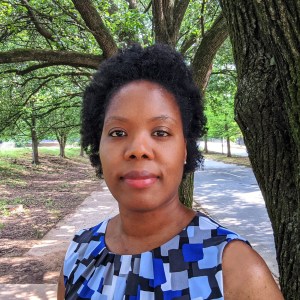
Abstract
Craft practices, knowledges, and communities are disappearing. These practices carry with them histories and cultures of people, knowledges, and social ties to communities. Some reasons for their disappearance include dying practitioners, lacking pedagogy, changing practices, and technocentric developments. How might we employ computation in the restoration, remediation, and reconfiguration of these practices, knowledges, and communities? Additionally, how might knowledges and innovations in these crafts, repair problems and improve research, practice, and pedagogy in computational design? This presentation will share my research into craft and computation such that our field touches the ground, communities, and critically considers access.
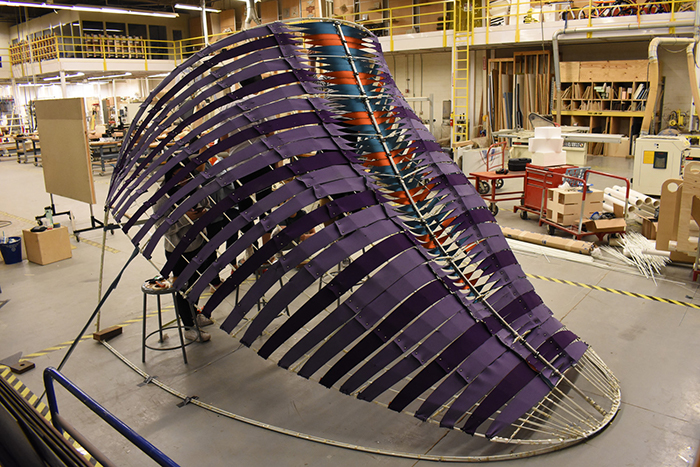
Bio
Vernelle A. A. Noel, Ph.D. is a design scholar, architect, artist, and Founding Director of the Situated Computation + Design Lab at the Georgia Institute of Technology. Currently an Assistant Professor in the School of Architecture and the School of Interactive Computing, her research examines traditional and automated making, human-computer interaction, interdisciplinary creativity, and their intersections with society. She builds new expressions, tools, and methodologies to explore social, cultural, and political aspects of computational design, and emerging technologies for new reconfigurations of practice, pedagogy, and publics. Her work has been supported by the Graham Foundation, the Mozilla Foundation, and ideas2innovation, among others, and she is a recipient of the 2021 DigitalFUTURES Young Award for exceptional research and scholarship in the field of critical computational design. Dr. Noel has been a Visiting Professor, researcher, and educator at the Cluster of Excellence in Computational Design (IntCDC) at the University of Stuttgart, the University of Florida, Penn State, MIT, the Singapore University of Technology & Design, and has practiced as an architect in the US, India, and Trinidad & Tobago.

For more information about the MAT Seminar Series, go to: seminar.mat.ucsb.edu.
For previous seminars, please visit our MAT Seminars Video Archive.
Tuesday, March 8th, 2022
12 noon PST via Zoom
Abstract
Vishnu Narayan Bhatkhande (1860 – 1936) was one of the most prominent musicologists in the history of India who wrote the first modern treatise on North Indian Classical Music, an art which had been propagated earlier mostly through oral tradition. Early in the 20th Century CE, he wrote a series of books of great current renown; perhaps the best-known of these is his Hindustānī Sangīt Paddhati – Kramik Pustak Mālikā (System of Hindustani Music - Book Series), written in the North Indian language Marathi, in which he outlined his system of the categorization of the North Indian modal system: he classified the hundreds of known rāga-s (scales replete with instructions for melodic movement) into ten modes called thāṭ-s which form the basis of current North Indian Classical Music theory. This six-volume work illustrates the rāga-s and their thāṭ-s by the inclusion of ~1900 different short Hindustani classical music compositions. In 1968 the Czech-born composer Walter Kaufmann, then professor of musicology at Indiana University, Bloomington, published his book The Ragas of North India, in which he transcribed into Western staff notation a generous selection of the compositions in Bhatkhande’s Kramik Pustak Mālikā. However, Bhatkhande’s work – apart from Volume I, a very brief introductory booklet comprising only 68 pages – has never been translated into English. This project has as its goal the porting into Western staff notation of all ~1900 compositions in the 3,500-odd pages of the Kramik Pustak Mālikā to make it accessible to the Western music community. Given the large scope of the work, the solution is to leverage and build technology into the software platform - InSargam - Indian Classical Music Notation Editor that can export Western staff notation and accomplish this task.
Wednesday, March 9th, 2022
3pm PST via Zoom
Abstract
When a sound source is spatialized over loudspeakers, the source undergoes a series of transformations before it ultimately reaches the listener. The source is first transformed by panning and other spatialization algorithms based on its spatial parameters in what this dissertation calls the virtual field. Next, the source is projected by the loudspeaker array into the acoustic field further transforming the source. The virtual field, loudspeaker array, and acoustic field form the spatial audio field (SAF) which significantly influences how a spatial composition is perceived.
The majority of current spatial techniques focus on manipulation of a source's spatial parameters and parameters of the spatial image. While sources in spatial audio compositions are assigned positions and trajectories that often change throughout the work, the spatialization algorithms of the virtual field are usually fixed, the loudspeaker array does not change, and the acoustic field rarely changes during the performance. Thus the specific SAF used in a given work, whether constructed deliberately as part of the compositional process, or constructed arbitrarily, is usually static.
The SAF is largely unexplored for new compositional techniques on short musical timescales. As the loudspeakers and acoustic field are physical components of the SAF, changes to each are only practical on larger timescales from musical phrases to form. However, as the virtual field is usually constructed digitally, it can be changed on timescales down to the sample rate. Therefore, the focus of this research is on developing compositional techniques in the virtual field.
To carry out this research, an experimental software program was developed that not only allows for realtime spatialization of multiple audio sources, but also allows for realtime changes to the virtual field. This research has led to the development of new compositional elements, methods of synthesis, and spatial extensions to traditional compositional techniques.
Speaker: Sharon Daniel
Monday, February 28th at 1pm PST via Zoom
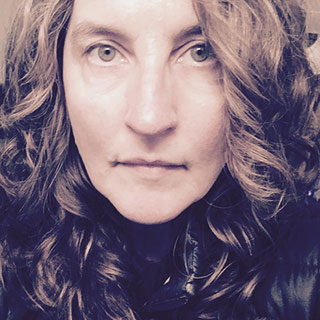
Abstract
In the 15th century, Venetians invented Quarantine as a protection against the plague. In the Mid-20th century, Americans invented a criminal punishment system based on the model of Quarantine in which the disproportionately poor, Black, or Brown ‘offender” is treated as a pathogen to be isolated and contained. In the 21st century, COVID-19, an actual pathogen, has both exposed and intensified the brutality of that system — prisoners have been stranded in quarantine without adequate food or medication, abandoned and unseen. In the US over 2 million people are confined in overcrowded, unsanitary, and unsafe environments. Prisoners cannot practice social distancing or use hand sanitizer and are regularly subjected to medical malpractice and neglect. In this seminar presentation, I will focus on the interactive documentary EXPOSED, which provides a cumulative public record and evolving history of the coronavirus pandemic’s impact on incarcerated people. EXPOSED, documents the spread of COVID-19, over time, inside prisons, jails, and detention centers across the US, from the perspective of prisoners and their advocates. Original interviews, along with quotes, audio clips, and statistics collected from a comprehensive array of online publications and broadcasts, are assembled into an interactive timeline that, on each day, offers abundant testimony to the risk and trauma prisoners experience under coronavirus quarantine. The scale of the project is intended to reflect the scale of the crisis. There are now over 11,000 entries in the project database. The monochrome, image-less, headline-styled interface, which allows viewers to step through thousands of prisoners’ statements, is designed to visualize their collective suffering and signal that the injustices they endure are structural.
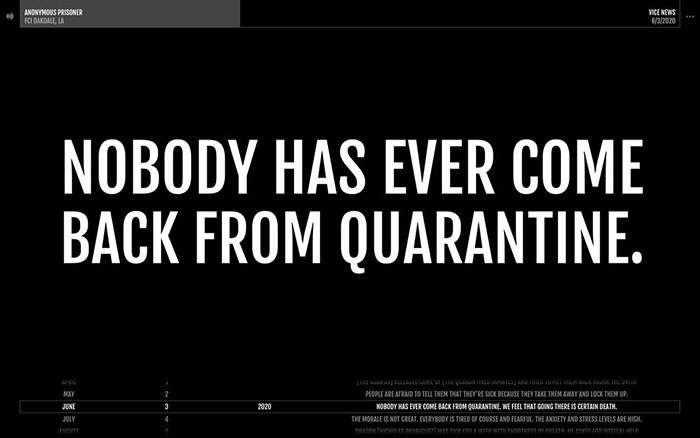
Bio
Sharon Daniel is a media artist who creates interactive and participatory documentary artworks addressing issues of social, racial, and environmental injustice, focusing principally on mass incarceration and the criminal legal system. She develops innovative online interfaces and multi-media installations that visualize and materialize the testimony of incarcerated people. Her work has been exhibited in museums and festivals internationally. Her work has been honored by the Webby Awards, a Rockefeller/Tribeca Film Festival New Media Fellowship, and a Fulbright Fellowship. She was named in the Yerba Buena Center for the Arts “YBCA 100” – a list of “the creative minds, makers, and pioneers that are asking the questions and making the provocations that will shape the future of American culture.” Daniel is a Professor of Film and Digital Media at the University of California, Santa Cruz.
For more information about the MAT Seminar Series, go to: seminar.mat.ucsb.edu.
For previous seminars, please visit our MAT Seminars Video Archive.
Speaker: Sofian Audry
Monday, February 14th at 1pm PST via Zoom
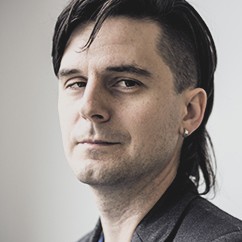
Abstract
A talk by transdisciplinary artist-researcher Sofian Audry on machine learning art and its practice in new media art and music, presenting as an overview of Audry's new book at MIT Press.
Bio
Sofian Audry is an artist, scholar, Professor of Interactive Media within the School of Media at the University of Quebec in Montreal (UQAM) and Co-Director of the Hexagram Network for Research-Creation in Art, Culture and Technology. Audry's work explores the behavior of hybrid agents at the frontier of art, artificial intelligence, and artificial life, through artworks and writings. Audry's book Art in the Age of Machine Learning examines machine learning art and its practice in art and music (MIT Press, 2021). Their artistic practice branches through multiple forms including robotics, installations, bio-art, and electronic literature.
For more information about the MAT Seminar Series, go to: seminar.mat.ucsb.edu.
For previous seminars, please visit our MAT Seminars Video Archive.
Speaker: Simon Penny
Monday, February 7th at 1pm PST via Zoom
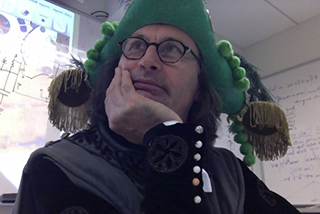
Abstract
This presentation will focus on my research into distributed, inactive, and embodied cognition as it relates to the arts, and on my critical interrogation of computing history and rhetoric - all of which has arisen out of, and in parallel with, my practice as an artist in interactive, robotic and virtual media. The presentation will begin with an introduction to two works, followed by a discussion of the philosophical ideas that have informed computing and the mind. Questions will gravitate around the issues raised during the presentation and around the two assigned papers: One examines the history of digital media arts in the 90s, the other addresses issues of cognition related to contemporary digital media.
Bio

Simon Penny is an artist, theorist, and teacher with a longstanding focus on emerging technologies and on embodied and situated aspects of artistic practice. He has built interactive installations and robotic art since the mid-1980s. He explores - in artistic and scholarly work and in technical research - problems encountered when computational technologies interface with cultural practices. His longstanding concern for embodied and situated aspects of aesthetic experience, along with a critical analysis of computer culture, is the focus of his book Making Sense: Cognition, Computing, Art and Embodiment (MIT press 2017). He was director of A Body of Knowledge: Embodied Cognition and the Arts conference UCI 2016, and An Ocean of Knowledge: Pacific Seafaring, Sustainability and Cultural Survival at UCI in 2017. He is co-director of the Industrial Crafts Research Network. He was Professor of Art and Robotics at Carnegie Mellon (1993-2000). He founded the Arts Computation Engineering (ACE) graduate program at the University of California Irvine, 2001-2012. He was visiting professor in media theory, Cognitive Systems, and Interactive Media masters, University Pompeu Fabra, Barcelona, 2006-2013, and Labex International Professor, University Paris8 and ENSAD in 2014. Penny is currently a professor in Electronic Art and Design (Dept of Art) at the University of California, Irvine, with appointments in the dept of Music and in Informatics (School of Information and Computer Science). He is a guest professor at the School of Art and Design, Nottingham Trent University UK, 2021-2024.
For more information about the MAT Seminar Series, go to: seminar.mat.ucsb.edu.
For previous seminars, please visit our MAT Seminars Video Archive.
Speaker: Maja Smrekar
Monday, January 31st at 1pm PST via Zoom
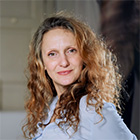
Abstract
Artist talk on Maja Smrekar’s work that derives on an interdisciplinary artistic research, exploring intersections between the human and the animal and intertwines these contexts with technology. Her work stems from the premise that human life is above all, about other than human entities that disrupt the division into subject and object. In her attempts to challenge these relations, she establishes contexts beyond the laws of genus and species or race or gender, constructing situations that happen on a (micro-)political level and furthermore on a molecular one. Drawing inspiration from different media, including performative elements, such as durational and photo performance; Smrekar extends her work into micro performativity that emphasizes on the processes within the human body and also includes nonhuman subjectivities.
Bio
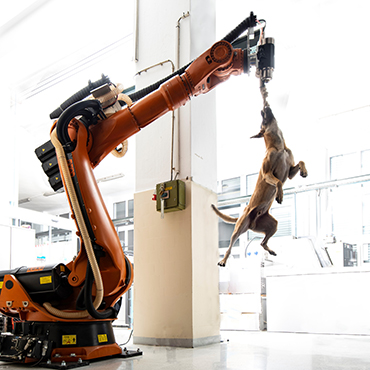
Smrekar's work has been established in the international art and science milieu. Her projects explore the potentials of technologically and scientifically rooted processes and materials, such as from biotechnology, molecular biology, reproductive biomedicine, ecology, ethology, artificial intelligence, soft robotics, etc. Her practice has allowed her to lead strong collaborations in developing productions that include cross-conceptual staging of hybrid art, performance, installations, site-specific, and video as well as contributions to knowledge exchanged within lectures, talks and texts. She exhibited in the following spaces: ZKM Karlsruhe (Germany), Hyundai Motorstudio Beijing (China), MAXXI - National Museum of 21st Century Art in Rome (Italy), Zuercher Gallery / Frieze New York (USA), RMIT Gallery Melbourne (Australia), etc. and festivals: Ars Electronica (Linz, Austria), Click festival (Elsinore, Denmark), Transmediale (Berlin, Germany) ... In 2017 she was the recipient of the Prix Ars Electronica - Golden Nica 2017 in the Hybrid Arts Category (Linz / Austria).
For more information about the MAT Seminar Series, go to: seminar.mat.ucsb.edu.
For previous seminars, please visit our MAT Seminars Video Archive.
Speaker: Jonas Jørgensen
Monday, January 24th at 1pm PST via Zoom
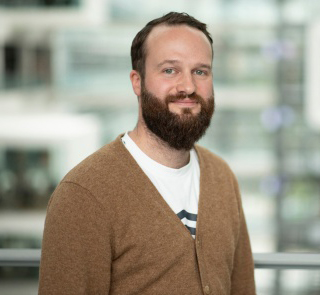
Abstract
Soft Robotics designates a novel approach to designing robots anchored in the simple idea of using compliant structures and elastic materials rather than rigid metal or plastic parts. In this seminar talk, I introduce the research and creation program of Soft Robot Aesthetics that seeks to unite interests and methodological approaches drawn from artistic research, art history, human-robot interaction, and technical soft robotics research. The broad overall aim of this body of work is to explore alternative versions of what soft robotics might be or become if approached from the point of view of art and aesthetics, and how a more nuanced understanding of the potentials and consequences of rendering a robot soft can be attained through aesthetic practices. The talk describes selected work done at the Center for Soft Robotics at the University of Southern Denmark, including our ongoing collaboration with Maja Smrekar on the final chapter of the !brute_force series. Through methodological considerations and reflections on case study projects, I aim to illustrate how artistic and aesthetic perspectives may generate distinct types of questions and insights about soft robots, as well as singular outcomes, of which some are useful for robotics research more broadly.
Bio
Jonas Jørgensen is Assistant Professor at the Center for Soft Robotics at the Biorobotics section of the University of Southern Denmark. Jonas was originally trained as a physicist (BSc) and an art historian (BA, MA) at Univ. of Copenhagen and Columbia University (New York). He received a Ph.D. degree at the IT University of Copenhagen as a member of the Robotics Evolution and Art Lab (REAL). Jonas’s research and practice span the fields of robotic art, soft robotics, human-robot interaction, and media art history. He has presented papers and organized workshops at several high-ranking international conferences and is the author of more than 20 peer-reviewed publications. With different collaborators, Jonas has created robotic art projects that have been exhibited internationally at institutions including Ars Electronica (Linz, Austria), Chronus Art Center (Shanghai, China), and Science Gallery Dublin. Jonas currently serves as a management committee member representing Denmark in the EU COST action CA18136 “European Forum for Advanced Practices” (2019-2023) that focuses on emerging practice-based transdisciplinary practices. Together with Maja Smrekar, he is also a partner in the EU’s STUDIOTOPIA program.
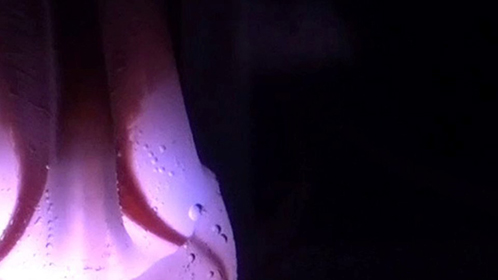
For more information about the MAT Seminar Series, go to: seminar.mat.ucsb.edu.
For previous seminars, please visit our MAT Seminars Video Archive.
Speaker: Marcos Lutyens
Monday, January 10th at 1pm PST via Zoom
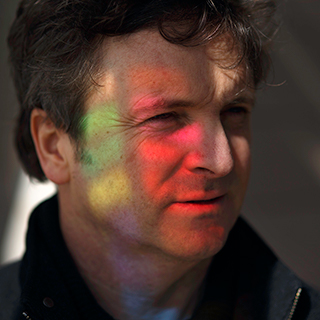
Abstract
A talk by internationally recognized artist Marcos Lutyens covering the trajectory of his work that centers around consciousness. His emergent work spans neuroscience, shamanism, performance art, hypnosis, networked video, augmented reality, and various other art forms, seeking to expand what we consider to be the roots of consciousness.
Bio
In his explorations of consciousness, Lutyens has collaborated with celebrated neuroscientists V. Ramachandran and Richard Cytowic, as much as studying under shamans from different cultures. His works take form in installations, sculptures, drawings, short films, writings, and performances. Lutyens has exhibited internationally in numerous museums, galleries, and biennials, including the Royal Academy of Arts, Centre Pompidou, National Art Museum of China, Documenta, and the Biennials of Venice, Istanbul, Liverpool, São Paulo.
For more information about the MAT Seminar Series, go to: seminar.mat.ucsb.edu.
For previous seminars, please visit our MAT Seminars Video Archive.
Thursday January 13th at 6pm Pacific Time via Zoom.
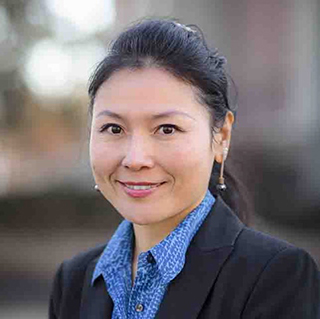
This lecture introduces an innovative online teaching pedagogy in sound design and modular synthesis. It uses open-source software to improve student-centered learning outcomes during the ongoing COVID-19 pandemic. We wanted to achieve a similar level of engagement as in-person classes, inspire a diverse student body, offer ample technical and mental support, as well as open the possibility of learning sound design through Eurorack modular synthesizers without investing money in expensive hardware. Human subjects research was conducted during the course to improve the students’ learning experience and shape the pedagogy. The qualitative and quantitative data indicates the effectiveness of student-centered pedagogy. We promoted social interaction and student well-being while teaching challenging topics during challenging times.
Dr. Jiayue Cecilia Wu is a scholar, composer, vocalist, multimedia technologist, and audio engineer. She earned her Bachelor of Science degree in Design and Engineering in 2000. She then worked as a professional musician at Universal Music Group and EMI Records for ten years. In 2013, she obtained a Master of Arts degree in Music, Science, and Technology at Stanford University. In 2018, she received a PhD in Media Arts and Technology from the University of California Santa Barbara. Dr. Wu's work focuses on designing and using media technology to compose music for meditation and healing. Her work has been exhibited at museums and arts/science societies such as the National Museum of China, Denver Art Museum, IEEE, Linux Audio, ISEA, ICMC, NIME, AES, and SEAMUS. She is the chairperson of the Diversity, Equity, and Inclusion Committees for both AES and Colorado MahlerFest. She also serves as a voting member of the Recording Academy (Grammy), the Editor-in-Chief of SEAMUS, and the board director-at-large of ICMA. Currently, Dr. Wu is an assistant professor at the University of Colorado Denver’s College of Arts and Media.